 What could be a tastier, better snack than some crispy, caramel-dipped locusts? If you’re like most people, then your answer is “ pretty much anything else!” Eating bugs is surely something only done by contestants on Fear Factor; it would seem very un-Jewish and non-kosher.
What could be a tastier, better snack than some crispy, caramel-dipped locusts? If you’re like most people, then your answer is “ pretty much anything else!” Eating bugs is surely something only done by contestants on Fear Factor; it would seem very un-Jewish and non-kosher.
However, in the Torah, certain locusts are indeed listed as being kosher. But which ones are they? And can they still be eaten today? And why on earth would God license us to eat them?
This week’s Torah portion, Parshat Re’eh, presents lists of kosher and non-kosher creatures that provide further intriguing questions. The list of kosher animals includes the tzvi, which is usually translated as “deer,” but it also mentions the ayal, which is rendered in some translations as a hind. But, what’s a hind? It’s a doe! A deer! A female deer. Well, the tzvi and ayal can’t both be deer, so one of them has to be something else—but what?
Another kosher animal in this parsha is called the zamer. This is famously identified by Rav Saadiah Gaon as the giraffe. But is it plausible to posit that the Children of Israel were familiar with giraffes? And is the giraffe actually kosher—and, if so, why don’t we eat it? (The answer is not what you’ve been told!)
Then there’s the list of non-kosher birds, topped by the king of birds, the nesher. This is usually identified as an eagle, but this is problematic as there are verses describing the nesher as being bald. Eagles are not bald—even the famous American bald eagle has a lovely head of feathers; they are merely white (which was called “ balde” in Old English; the bird was originally called the “ balde-headed eagle” ). So if the nesher is not the eagle, what is it?
The answers to these questions and many others can be found at the amazing new Biblical Museum of Natural History in Beit Shemesh, Israel. The museum presents the animal world of the Torah in a spectacular array of live and taxidermied exhibits. A fascinating guided tour leads the visitors on a tour of the animal kingdom in Jewish thought, with countless opportunities to come face-to-face with extraordinary creatures and also to touch them.
The exhibit of kosher and non-kosher creatures, which introduces you to everything from giraffes to ostriches to sharks to locusts, are just one of the many exhibits at the museum. Another presents wild animals that are today associated with the jungles and savannahs of Africa but which used to live in the Land of Israel, including such beasts as the lion, cheetah, hyena, hippopotamus and crocodile. Then there is an exhibit of the world’s largest collection of exotic shofars, each made from a different species, and clarifying different aspects of the halachot of shofar. The “ shemonah sheratzim” exhibit presents live examples of the different rodents and reptiles of Scripture, which visitors are encouraged to handle! A video presentation shows museum director Rabbi Dr. Natan Slifkin explaining the Biblical symbolism of lions and leopards as he wrestles with semi-tame specimens in Africa. The introductory presentation on “ The Wonders of Creation” exhibits some of the most beautiful and extraordinary creatures in the animal kingdom, guaranteed to take your breath away. Outside, a petting zoo provides an opportunity for the younger visitors to play with bunnies, chickens, a giant tortoise and other cute and cuddly critters. Tours usually conclude with visitors posing for the camera while holding (or being held by) a 10-foot python!
Visits to the Biblical Museum of Natural History are conducted via guided tours only, enabling every visitor to gain the maximum benefit from the experience, which includes supervised handling of creatures and exhibits. Tours must be booked in advance, and are available in English, Hebrew and Yiddish! Sukkot is a popular time to visit the museum, but tours on Sukkot tend to sell out quickly, so try to book as far ahead as possible.
If you’re going to be Israel on October 13, you might want to become a patron of the museum so that you can receive an invitation to the museum’s “ Exotic Biblical Dinner.” This unique event, held at the museum itself, will serve all kinds of exotic creatures that are described in the Bible as being eaten. The gourmet experience, prepared by internationally famous chef Moshe Basson, will include quails (as eaten by the Children of Israel in the wilderness), venison (as served at King Solomon’s table) and numerous other species. Each dish will be introduced with a presentation about the significance of that creature in the Torah, and a variety of rabbinic and other dignitaries are expected to be in attendance. Dessert will, of course, be crispy, caramel-dipped locusts; however, an option of chocolates in the shape of locusts will be provided for the locust-intolerant. Bon appetit!
Learn more about the Biblical Museum of Natural History at www.BiblicalNaturalHistory.org.
By JLNJ Staff










